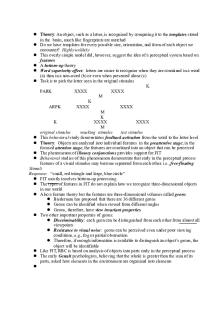Possible Cognitive Psychology Exam Questions PDF

| Title | Possible Cognitive Psychology Exam Questions |
|---|---|
| Course | Introduction to Cognitive Psychology |
| Institution | Lakehead University |
| Pages | 1 |
| File Size | 35.4 KB |
| File Type | |
| Total Downloads | 49 |
| Total Views | 145 |
Summary
Possible topics for the long answer questions on the final exam...
Description
Exam Review Long Answer Questions 1. Bechara et al. (1999) examined deficits following damage to amygdala and ventromedial frontal cortex. Two patient groups and a control group were tested in the IOWA gambling task. IGT contains advantageous (you win over time) and disadvantageous (you lose over time). They measured the number of cards selected from the two types of decks in 100 trials (only one card could be selected per trial and anticipatory Skin conductance responses (SCRs) as well as outcome SCRs. Describe the pattern of card selection from the two deck types for each group, and the pattern of anticipatory and outcome SCRs for each group. What did Bechara et al. conclude about decisions and damage to amygdala and ventromedial frontal cortex: 2. Shallice (1982) tested two groups of patients, with Frontal and Parietal lesions, on two problem solving tasks, Tower of London and WAIS block design, and reported a double dissociation in performance between lesion location and problem task. Briefly describe the two tasks, the patient groups performance. and Shallice (1982) concluded about problem solving: 3. It has been claimed that there is a certain critical period when it is easiest to learn a language. At what age is the critical period. There are a great many differences among adults versus the older children versus younger children in terms of amount of linguistic exposure, type of exposure (e.g. whether sports, history, or shopping are being discussed), and willingness to try to learn (McLaughlin, 1978; Nida, 1971). How do these factors influence our understanding of a critical period for language [refer to the Ervin-Tripp (1974) study]? How does age of language acquisition affect ultimate language mastery [refer to the Newport & Supalla (1987) study of ASL]? 4. As discussed in class the Wernicke–Geschwind model of the Neurology of Language has three components. Identify and briefly describe these, include information about location and function: 5. In class we discussed three broadly defined categories of Aphasias. Identify and briefly discuss these aphasias: 6. Identify the weapon focus hypothesis and Yerkes-Dodson Law and describe how each is thought to affect memory for emotional events:...
Similar Free PDFs

COGNITIVE PSYCHOLOGY
- 591 Pages

SP605 Cognitive Psychology
- 70 Pages

Cognitive Psychology Paper 3
- 5 Pages

Cognitive psychology notes
- 26 Pages

Cognitive psychology 3
- 3 Pages

Cognitive Psychology Unit-1
- 14 Pages

Cognitive Psychology Class 2
- 8 Pages
Popular Institutions
- Tinajero National High School - Annex
- Politeknik Caltex Riau
- Yokohama City University
- SGT University
- University of Al-Qadisiyah
- Divine Word College of Vigan
- Techniek College Rotterdam
- Universidade de Santiago
- Universiti Teknologi MARA Cawangan Johor Kampus Pasir Gudang
- Poltekkes Kemenkes Yogyakarta
- Baguio City National High School
- Colegio san marcos
- preparatoria uno
- Centro de Bachillerato Tecnológico Industrial y de Servicios No. 107
- Dalian Maritime University
- Quang Trung Secondary School
- Colegio Tecnológico en Informática
- Corporación Regional de Educación Superior
- Grupo CEDVA
- Dar Al Uloom University
- Centro de Estudios Preuniversitarios de la Universidad Nacional de Ingeniería
- 上智大学
- Aakash International School, Nuna Majara
- San Felipe Neri Catholic School
- Kang Chiao International School - New Taipei City
- Misamis Occidental National High School
- Institución Educativa Escuela Normal Juan Ladrilleros
- Kolehiyo ng Pantukan
- Batanes State College
- Instituto Continental
- Sekolah Menengah Kejuruan Kesehatan Kaltara (Tarakan)
- Colegio de La Inmaculada Concepcion - Cebu








